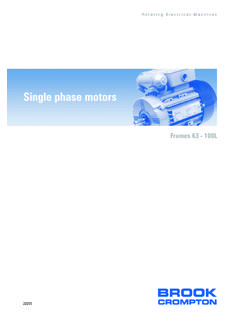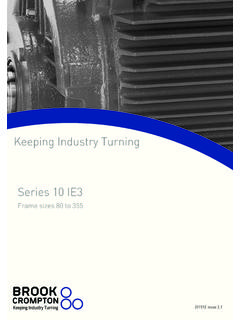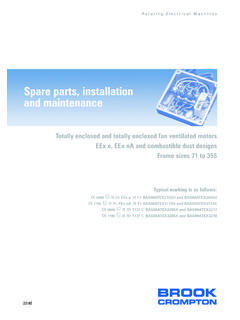Transcription of Variable Speed Driven Pumps - Brook Crompton
1 Variable Speed Driven Pumps Best Practice Guide A U T O M AT I O N. I N S T R U M E N TAT I O N & C O N T R O L. L A B O R AT O R Y T E C H N O L O G Y. H. P1 P1+2 P1+2+3. 0. 0 Q. Variable Speed Driven Pumps -BEST PRACTICE GUIDE. PREFACE AND ACKNOWLEDGEMENTS ..3. SECTION 1 SECTION 2 PUMPING SYSTEM HYDRAULIC SYSTEM PUMP CURVES ..6. PUMP OPERATING POINT ..7. SECTION 3 ROTODYNAMIC PUMP PRINCIPLES & PERFORMANCE EFFECT OF Speed EFFECTS OF IMPELLER DIAMETER PUMP SUCTION PERFORMANCE (NPSH)..11. METHODS OF VARYING PUMP THE NEED FOR PERFORMANCE PUMP CONTROL BY VARYING Speed ..12. Pumps IN PARALLEL SWITCHED TO MEET DEMAND ..14. STOP/START CONTROL ..15. FLOW CONTROL BY-PASS CONTROL ..16. SECTION 4 POSITIVE DISPLACEMENT Pumps .
2 17. PUMP PRINCIPLES, TYPES AND PERFORMANCE METHODS OF VARYING PUMP PUMP CONTROL BY VARYING Speed ..18. FLOW CONTROL USING Pumps IN Pumps IN SERIES (ROTARY) ..21. FLOW CONTROL BY-PASS CONTROL ..21. LOAD/UNLOAD SECTION 5 MOTORS .. 22. MOTOR PRINCIPLES ..22. MULTI- Speed MOTORS ..22. ENERGY EFFICIENCY OTHER ENERGY SAVING MOTOR SWITCH IT OFF! ..25. A MOTOR MANAGEMENT SHAFT ALIGNMENT ..26. PULLEY SECTION 6 Variable Speed DRIVES .. 27. Variable FREQUENCY DRIVE PRINCIPLES 27. THE FREQUENCY INTERMEDIATE CONTROL PULSE WIDTH MODULATION ..29. INTEGRATED Variable Speed MOTORS ..29. SECTION 7 SELECTING A Variable Speed DRIVE FOR A NEW 30. SIZING & SELECTION .30. CONTROL 33. CONTROL BY FIXING PRESSURE BUT VARYING FLOW.
3 33. HEATING SYSTEM CONTROL ..33. CONTROL BY FIXING FLOW BUT VARYING PRESSURE:..34. IMPLEMENTATION ..34. SOFT STARTING AND SECTION 8 RETROFITTING A Variable Speed DRIVE TO EXISTING 35. JUSTIFICATION .35. MOTOR DERATING ..35. 1. Variable Speed Driven Pumps -BEST PRACTICE GUIDE. SIZING AND SELECTION OF A VSD ON EXISTING EQUIPMENT 36. SECTION 9 EFFECTS OF NOISE & VIBRATION WHEN VARYING Speed .. 39. TYPICAL NOISE LEVELS 39. Pumps .. 40. MOTORS 41. APPENDIX ADDITIONAL INFORMATION 41. A1 MAGNETIC DRIVE Pumps .. 41. EFFECTS OF PUMP Speed 41. EFFECTS OF DIAMETER CHANGE ..41. A2 MOTOR CONSIDERATIONS .. 41. PROTECTION ..41. Speed ..42. INSULATION DESIGN ..42. MOTOR BEARINGS ..42. A3 LEGISLATIVE 43. THE MACHINERY THE EMC RADIATED CONDUCTED EMISSIONS.
4 44. THE LOW VOLTAGE DIRECTIVE ..44. THE ATEX DIRECTIVE ..45. THE CE MARKING DIRECTIVE ..45. A4 45. A5 REFERENCES AND FURTHER 46. 2. Variable Speed Driven Pumps -BEST PRACTICE GUIDE. PREFACE AND ACKNOWLEDGEMENTS. This guide is the result of co-operation between three different industries whose goal was to produce a document that would clearly define; in simple terms the information required when planning to use an electronic Variable Speed Driven Pumping System. The guide focuses mainly on applications within the Industrial Sector, however the principles used will be applicable to most pumping applications. Members from the British Pump Manufacturers' Association (BPMA), Gambica's Variable Speed Drive group and experts from the Electric Motor industry assisted with this guide.
5 The chairman of the working group is indebted to all the team members for their contributions. In particular a special mention should be given to: - Geoff brown ABB Ltd., Drives & Motors Darren Henighan Brook Crompton Motors Ian James HMD Sealless Pumps John Bower Flowserve John Drane Mono Pumps John Thorne ITT Goulds Pumps Mike Moss Weir Pumps Peter Thompson david brown union Pumps Robin Piper- GAMBICA George Fraser - GAMBICA. Justin Brock Action Energy. Sponsorship has been provided by Action Energy (formerly the Energy Efficiency Best Practice Programme). This continued support for energy saving equipment ensures that documents like this can be published. To ensure the guide achieved its goal, copies were circulated to Technical Experts outside the working group who offered comment and direction.
6 The entire working group are grateful for this extra guidance. A special mention should be given to: - Steve Moore Ineos Chlor Bob Went Thames Water Utilities Morris Yates AEMS Derek Burgoyne- Pump Consultant Dr Hugh Falkner FES Brian Nesbitt- Pump Consultant Steve Schofield Director Technical Services BPMA. (Chairman of the VSD working group). 3. Variable Speed Driven Pumps -BEST PRACTICE GUIDE. SECTION 1 INTRODUCTION. Pump systems are often operated inefficiently. The reasons will vary from process to process and application to application, but the constant outcome is the cost to industry through wasted energy, which runs into millions of pounds per year, and the cost to the environment through the generation of this wasted energy.
7 It is estimated that in the Unite d Kingdom, Pumps use a total of 20 TWh/annum, responsible for the emission of ( million tons of carbon). Pumps therefore represent the largest single use of motive power in industry and commerce as shown in the breakdown of energy usage by motor Driven equipment: Pumps -31%. Fans- 23%. Air Compressors- 8%. Other Compressors 14%. Conveyors 8%. Others 16%. A pump installation is often sized to cope with a maximum predicted flow, which, may never happen. This principle of over sizing is frequently used in Industry, which subsequently leads to wasted energy and damage to parts of the pump installation. Procurement costs of the pump equipment in general amount to less than 1% of the total investment of a plant, yet the operational quality of a pump may be the decisive factor in the overall functionality of the plant and its associated running costs.
8 Flow control by Speed regulation of Pumps , is one of today's best methods of varying the output on both Rotodynamic and Positive Displacement Pumps and this guide describes its many advantages and potential system drawbacks. The benefits covered include: Energy cost savings Reliability improvements Simplified pipe systems (elimination of control valves & by-pass lines). Soft start & stop Reduced maintenance All amounting to lower life cycle costs. Whilst other methods of control are available, this guide concentrates on Pulse Width Modulated Variable Speed Drive because it has the greatest benefits of control, energy efficiency, and ease of retrofitting. 4. Variable Speed Driven Pumps -BEST PRACTICE GUIDE.
9 SECTION 2 PUMPING SYSTEM HYDRAULIC CHARACTERISTICS. SYSTEM CHARACTERISTICS. In a pumping system, the objective, in most cases, is either to transfer a liquid from a source to a required destination, filling a high level reservoir, or to circulate liquid around a system, as a means of heat transfer. A pressure is needed to make the liquid flow at the required rate and this must overcome head losses' in the system. Losses are of two types: static and friction head. Static head is simply the difference in height of the supply and destination reservoirs, as in Figure In this illustration, flow velocity in the pipe is assumed to be very small. Another example of a system with only static head is pumping into a pressurised vessel with short pipe runs.
10 Static head is independent of flow and graphically would be shown as in Figure STATIC HEAD. STATIC. HEAD. FLOW. Figure Figure 2 .2. Static head Static head vs. flow Friction head (sometimes called dynamic head loss) is the friction loss, on the liquid being moved, in pipes, valves and equipment in the system. The losses through these are proportional to the square of the flow rate. A closed loop circulating system without a surface open to atmospheric pressure, would exhibit only friction losses and would have a system head loss vs. flow characteristic curve as Figure FRICTION HEAD. FLOW. Figure Friction head vs. flow 5. Variable Speed Driven Pumps -BEST PRACTICE GUIDE. Most systems have a combination of static and friction head and the system curves for two cases are shown in Figures and The ratio of static to friction head over the operating range influences the benefits achievable from Variable Speed drives (see section ).









